Hi ! very interesting but i am not sure to understand what you have really doneLots of thinking but less doing.
So let me reveal a little anecdote of mine with a pair of dumpster find speakers from several years ago, the type of super cheap ones often following with a mini component stereo, like these Philips fwcb399 speakers
View attachment 1398551
These have quite a thin fiber wood walls, maybe a mere 7-8 mm, except for the front which is made from molded plastic and is maybe 2-3 mm thick and not much bracing at all like the ones seen in your attached image.
These speakers have a very boxy poor sound, so decided to play with these speakers just for fun by doing few small iteration changes to them, such as removing the grill to the tweeter which removed some hash (the super tweeter were fake), stuffing the box with damping materials (these had actually none inside), listened to them and the boxy sound had decreased quite a bit although still far from acceptable sounding, adding even more damping material and it improved a bit further, until the last step, separating the front from the box with speaker drivers in place, like this:
View attachment 1398552
ie. they would become an open baffle type of speakers, and placing the naked panel without the box on top of the woofer, and voila.. the boxy sound was virtually gone, that despite the crappy thin plastic front panel, so where does the boxy sound come from then, Gino? :)
Well, maybe the journey of anticipation, and thinking, is what brings more of satisfaction..
However i am quite done now Separating the woofer from all other drivers and putting it in a dedicated cabinet simplifies hugely the task
It is just a matter of design and build a not resonant bass box i.e. the goal of subs manufacturers
Subs usually have a cut around 150Hz max This will imply a 6.5" mid for the head unit A very common size for mids
a low Hz sweep test will make any resonance evident
Thanks i see Anyway i think that the baffle is a very peculiar panel By far the most critical one And actually usally is the thicker one i guess not only because has holesNo, I mean the total area of the box in relation to the area of the membrane. Large surface area means high efficiency, the speaker easily excites the panels without damping and stiffening. A large front baffle causes different problems. Reflections from baffle surface for example. The large width of the speakers again means that the baffle step is much lower than in narrow boxes.
I am not sure at 100% but it could be that what we perceive as boxyness are mostly front baffle vibrations/resonances
Of course also other panels can contribute but much less
Boxynes is the sound of resonances that you hear, due to the lack of damping in the box, or due to poorly dampened vibrations of the box's panels, or both. I wouldn't single out the panels, the only thing is that the front panel (unlike the others) is also weakened by the holes for the drivers and the drivers themselves are on it as a source of vibrations, that's why it's a little more critical than the others. But it doesn't have to be the main problem, there can be more vibrations on other panels.
If there is already such a problem, as I said, I would first add damping for the speaker itself (wadding or pyramidal sponge), and if that simple procedure does not give results, I would move on to stiffening and damping the walls of the box.
Excessive speaker damping can take away the life of the sound, so add a little at a time and listen to the results. For compression boxes, the entire volume is filled. For bass reflex and other resonant types, only the walls of the box are coated.
If there is already such a problem, as I said, I would first add damping for the speaker itself (wadding or pyramidal sponge), and if that simple procedure does not give results, I would move on to stiffening and damping the walls of the box.
Excessive speaker damping can take away the life of the sound, so add a little at a time and listen to the results. For compression boxes, the entire volume is filled. For bass reflex and other resonant types, only the walls of the box are coated.
Last edited:
Just for your perspective:Any coloration/resonance will cause a distorsion that will add at the musical signal I will hear the music and the box
i do not like at all
Any loudspeaker driver (in or outside a box) is resonant.
Adding a bass reflex tube or a passive resonator (sic!) adds an additional resonance. Transmission lines are resonators.
So resonance must not generally be a problem as such.
Adding weigth will increase the inertia of enclosure material, but it does not "absorb" vibration. It cannot do so, where would the energy go to? High weigth will be excited less, of course, but once excited it will oscillate longer.
Just imagine a heavy iron weigth hanging on a long wire. It takes some force (and work/energy) to move it significantly, but once it swings it will swing for a long time!
Edit: it may sound like I am constantly nitpicking, but I just want to point out that resonances cannot be completely avoided, even with very heavy enclosures. You just need to know whether a resonance will be a problem and how to deal with it.
Edit2: a post showing negative impact of port resonances in my port resonance absorber and geometry thread.
Last edited:
Any resonance is a problem unless one knows how quickly it dissipates the stored energy at any particular frequency and can damp it to ensure it remains below the audible noise floor.So resonance must not generally be a problem as such
This is extremely difficult with enclosures which are designed to be resonant or have high levels of stored energy.
So much effort is made to damp ported subwoofer enclosure walls when the entire concept revolves around a poorly damped Helmholtz resonator having resonances lasting orders of magnitude longer than the enclosure walls!
There are many speakers on the market that have Qts higher than 0.7-0.8, especially smaller speakers. The boxes are too small. Part of that is also a result of using a coil in front of the bass with a higher DC resistance. Let's say I measure driver TS parameters, Qt is greater than 0.5, and they put it in a small box with a bass reflex. It's an old trick that adds warmth and the impression that the bass is deeper than it really is, but also adds boominess and a tendency to sound like one note bass.
Some manufacturers put the drivers in resonant boxes to get a specific sound. They know everything well about damping and stiffening, but they do it on purpose. And it's cheaper too. This is how you get a "live" sound, which is not far from the truth, because the box plays its own song. 🤣 And live sound is always very different from commercial recordings.
Well-damped and stiff speakers sound too clean and boring anyway, that's just FiFi, and we've gotten over that a long time ago. Today we are looking for a lot of excitement and goosebumps. 😁
Yes, I agree...
T
looking inside some Genelec i see a very rigid shell but not much damping at allThe problem with metal is that it's resonant from nature. It's very stiff, but also very resonant. How to damp that is the difficult part of it. Genelec does it, and some others also, but many diy attempts fail. Wood is so much easier.
Do you mean that they used a special alloy for casting their cabinets ? it could be
clearly working on metal is almost impossible for a diyer wood is the only viable solution and it is fine
It is important to measure the resonances using a sweep
If i use the woofer lets say up to 300Hz and the resonances will start above that frequency there will be no resonances to tame
No damping needed
the check for resonances will be very easy
There is a material Corian used for kitchen tables
Not great for boxes. We used some in one as a veneer substitute on the top. That mass loads the box in the style GM recommends.
The picture is meant to highlight the µFonken, but it shows well the corian on top of the boxes it is sitting on.
dave
I'll mention two of my DIY enclosure ; the 375L and the 475L (below)
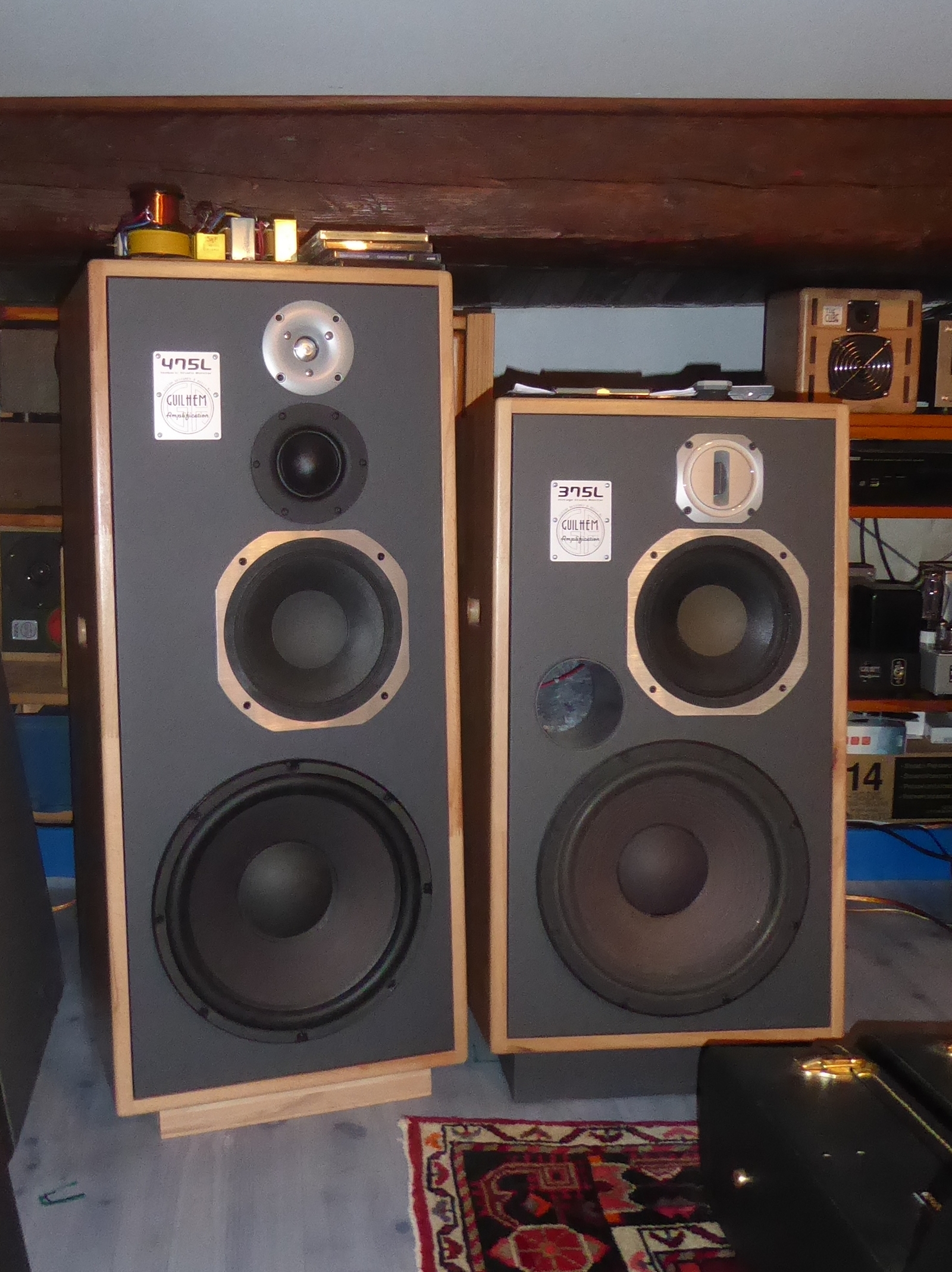
Here's how is built the 375L (Bass-Reflex type)
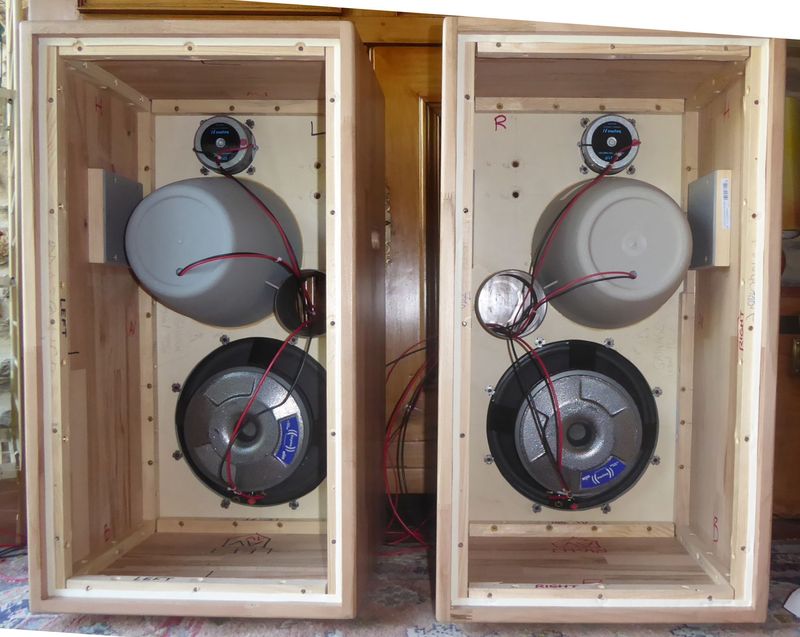
And the inside filling (40mm Cotton Wool mattresses) :
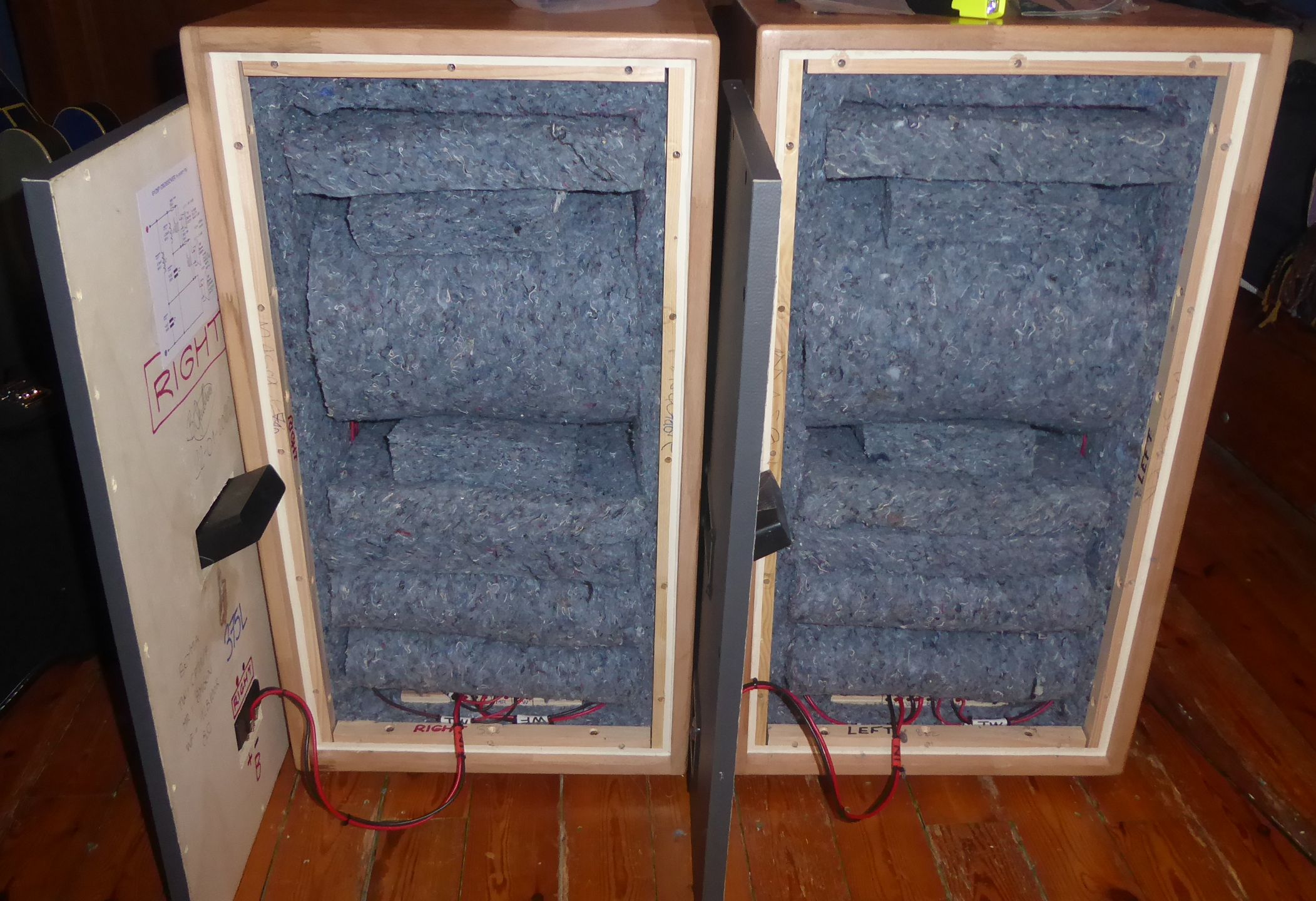
Here's how is built the 475L (Isobaric sealed type)
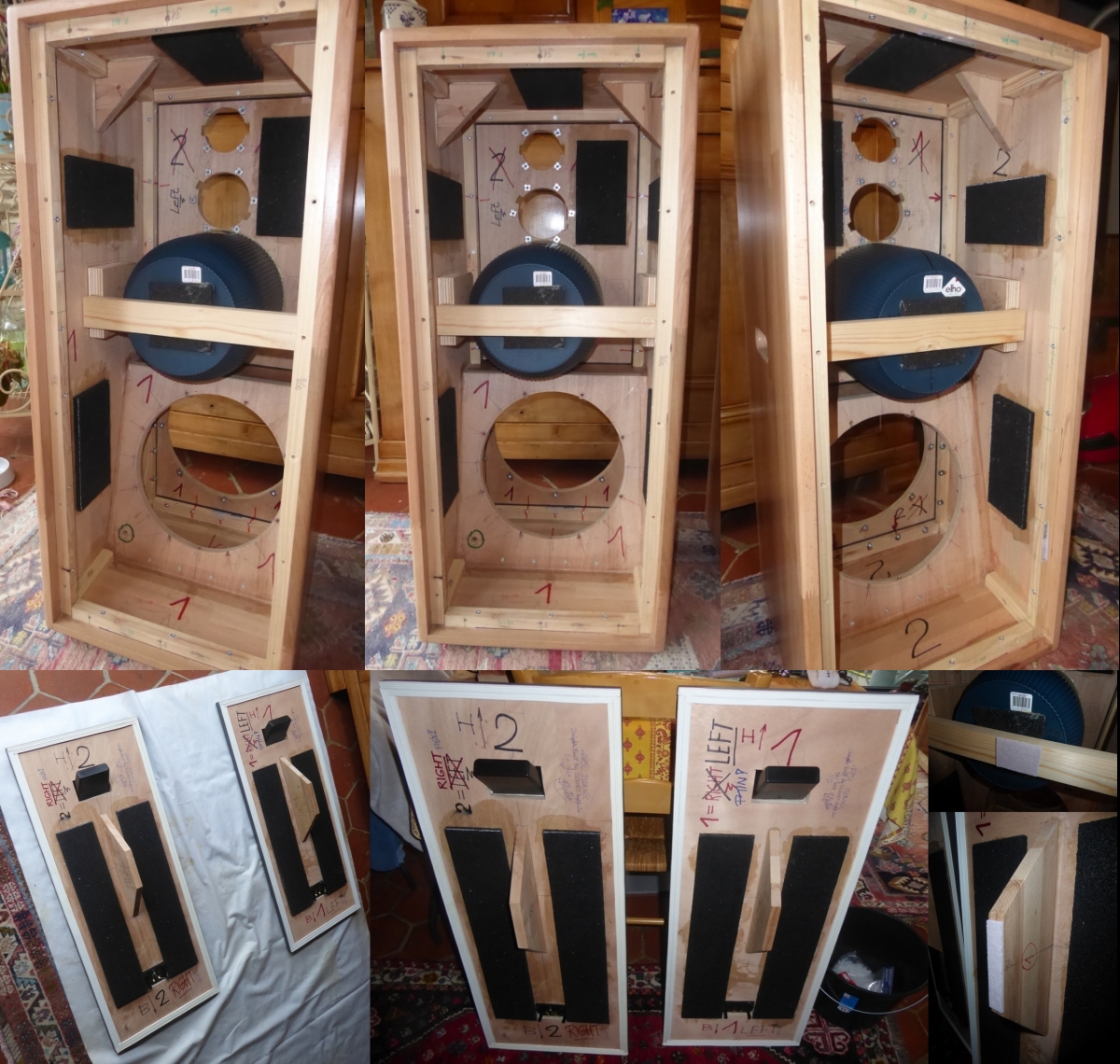
And the inside filling (40mm Cotton Wool mattresses) :
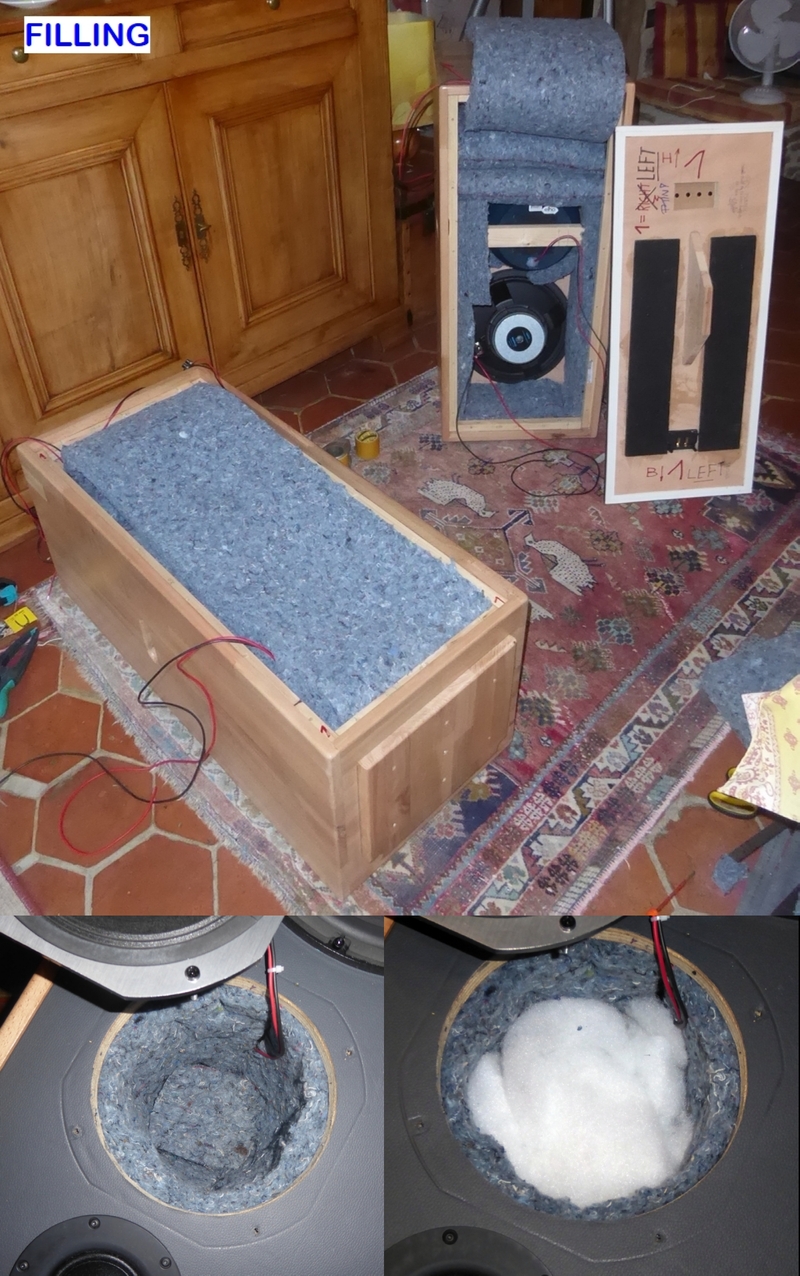
As you can see on those pictures :
* The 375L has no particular internal bracing, nor vibration damping material installed on the panels.
* The 475L benefits from panel-to-panel bracing, plus glued vibration damping material sheets.
Do I observe any tonal differences between the two cabinets ? That would be the question, and the answer is : non significative in terms of cabinet, tonally speaking, because the two speakers are from a different type, and just this provide much difference ortherwise, well over the cabinet construction by itself - even if the same materials were used for both.
Do I observe tactile vibrations of the panels at low volume ? Say comfortable, endless unfatiguing loudness 😊 = Nothing can be felt on any of the cabs.
Do I observe tactile vibrations of the panels at high volume ? Say temporary high "demo" loudness, the limit you can bear not too long = there's moderated vibrations on both as expected, the 375L having a bit more vibrations vs. the 475L, because of the absence of panel to panel bracing. I would have found a more conclusive tactile difference, though, and at the disadvantage of the non-braced 375L.
= there's moderated vibrations on both as expected, the 375L having a bit more vibrations vs. the 475L, because of the absence of panel to panel bracing. I would have found a more conclusive tactile difference, though, and at the disadvantage of the non-braced 375L.
What I can say here, is that no Boxy / Boomy sound is to be deplored, nor on the 375L, nor on the 475L, possibly because of the principles used (Isobaric QTC=0.7, low-tuning BR), the sufficient stifness of the panel material (Glulam Beechwood), the size and the proportions of the enclosures (heights 900mm and 750mm)...
That's why I rather subscribe to what @NIXIE62 wrote on post #110 :

T

Here's how is built the 375L (Bass-Reflex type)

And the inside filling (40mm Cotton Wool mattresses) :

Here's how is built the 475L (Isobaric sealed type)

And the inside filling (40mm Cotton Wool mattresses) :

As you can see on those pictures :
* The 375L has no particular internal bracing, nor vibration damping material installed on the panels.
* The 475L benefits from panel-to-panel bracing, plus glued vibration damping material sheets.
Do I observe any tonal differences between the two cabinets ? That would be the question, and the answer is : non significative in terms of cabinet, tonally speaking, because the two speakers are from a different type, and just this provide much difference ortherwise, well over the cabinet construction by itself - even if the same materials were used for both.
Do I observe tactile vibrations of the panels at low volume ? Say comfortable, endless unfatiguing loudness 😊 = Nothing can be felt on any of the cabs.
Do I observe tactile vibrations of the panels at high volume ? Say temporary high "demo" loudness, the limit you can bear not too long
 = there's moderated vibrations on both as expected, the 375L having a bit more vibrations vs. the 475L, because of the absence of panel to panel bracing. I would have found a more conclusive tactile difference, though, and at the disadvantage of the non-braced 375L.
= there's moderated vibrations on both as expected, the 375L having a bit more vibrations vs. the 475L, because of the absence of panel to panel bracing. I would have found a more conclusive tactile difference, though, and at the disadvantage of the non-braced 375L.What I can say here, is that no Boxy / Boomy sound is to be deplored, nor on the 375L, nor on the 475L, possibly because of the principles used (Isobaric QTC=0.7, low-tuning BR), the sufficient stifness of the panel material (Glulam Beechwood), the size and the proportions of the enclosures (heights 900mm and 750mm)...
That's why I rather subscribe to what @NIXIE62 wrote on post #110 :
T
Last edited:
Perfect ! what would be the easiest way to check for resonances ? i think i will need a signal generator an amp a petri dish some colored liquidBoxynes is the sound of resonances that you hear, due to the lack of damping in the box, or due to poorly dampened vibrations of the box's panels, or both.
running a sweep at high level there should not be waves on the liquid surface
If there will be waves that will be the sign of resonances
What i mean is that i cannot manage resonances if i do not know at which frequencies they pop up
i am sure that with most commercial speakers the water will come out of the petri dish at some point
thank you very much for the valuable advice I have to buy a signal generator It is impossible to run a test with musicI wouldn't single out the panels, the only thing is that the front panel (unlike the others) is also weakened by the holes for the drivers and the drivers themselves are on it as a source of vibrations, that's why it's a little more critical than the others. But it doesn't have to be the main problem, there can be more vibrations on other panels.
If there is already such a problem, as I said, I would first add damping for the speaker itself (wadding or pyramidal sponge), and if that simple procedure does not give results, I would move on to stiffening and damping the walls of the box.
Excessive speaker damping can take away the life of the sound, so add a little at a time and listen to the results. For compression boxes, the entire volume is filled. For bass reflex and other resonant types, only the walls of the box are coated.
I am sure that running a speaker with a signal generator would provide important information about the mechanical behaviour of the speaker
Maybe finding the right frequency it could collapse like the famous bridge ?
I would like to get on with the knob but slimmer than this one
it is cheap at 132 euro and it looks very cheap But i love the knob for making a sweep just rotating it
I do not understand if digital ones have the same feature A signal generator must have a knob like the famous Bruel & Kjaer
I do not understand if digital ones have the same feature. A signal generator must have a knob like the famous Bruel & Kjaer
Sure 😀 😎 ! Have a look to my (French Navy) FERISOL C902 Audio Generator from 1953, which is my "speaker tester" :
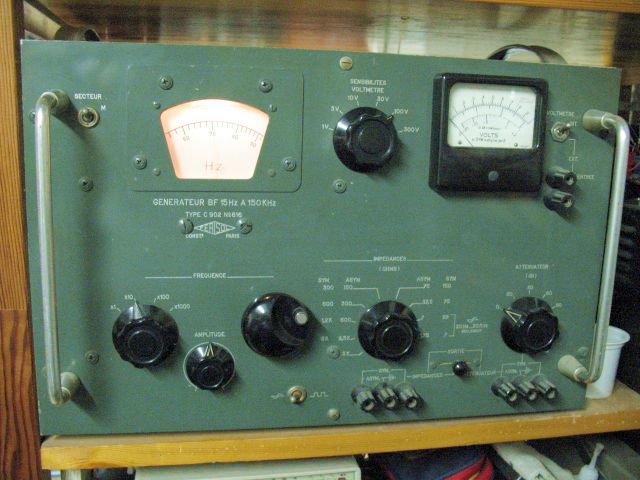
A full tube, Wien bridge oscillator, 45kg unit, fitted with a 6L6GC at the output stage, and switchable impedance from 5K to 1.75R, able to deliver 40VRMS output at 5K impedance. Despite its age, the frequency stability is still 0.1% on a whole day...
T
If using bitumen on only the opposite side of the cabinet walls you avoid tunefork colorations . This way, the untreated wall will have different weight and thus different resonanse behavior than the bitumen wall. The advantage can easily be heard with piano music, left hand articulation. I have experimented much with bitumen 4 years ago, - you are absolutely right that covering all the inside walls with bitumen only lowers the resonanses for the whole cabinet , making it sound worse than without any bitumen. And each of the box walls still has the same tunefork resonance frequencies, only slightly lower.For woofer cabinets, damping it with bitumen or lead based cladding does not solve it as it brings the resonances down in frequencies so they are still there but only lower (muddy bass). Bracing and stiffness of the cabinet are the main things that removes them. Stiffness is important to be more inert to vibrations, and bracing brings the frequency up, if you do it right, out of the passband of the woofer, and also reduces the amplitude of the resonance. Damping with lining can help also, but only for the higher frequencies (where bitumen and lead can work if the cabinet is seperate from the bass).
Best material that i know is still high quality void free birch wood. Some (Genelec) manage also to do it with a metal enclosure, but i think that is hard to do diy. I guess that some forms of (geo)polymers are also suited as they are heavy and often almost inert to vibrations, but again hard to do diy.
And MDF that is thick enough (very thick) can do it also, but it's not nice to work with and not that healthy for you and the envirroment, plywood is better overal.
Using bitumen on only each of the opposite walls in the cabinet is another story - sounding clearly better. Same effect can be had using different material or different thickness on every opposite loudspeaker wall. I.e building the box with 22mm, 19mm and 16 mm thickness of the walls.
Bracing pushes the resonanses upward in frequency which is a good thing for sound, but to much symmetrical bracing can make tunefork effects worse than without bracing, if one is unlucky.
Regarding damping material inside of a speaker , I have found that material that dont function as a spring usually sound more natural . Sheeps wool is very good sounding for midrange.
Last edited:
This is a common problem with Harman tuned loudspeakers, optimizing each speaker for mono listening with a flat response makes the sound stay where the speaker is, in stereo listening. One needs some stereo system compensation between 1-2 kHz ( +1.5 dB ) and 3,5 kHz ( -3 dB ) to make the sound holographic and 3 dimensional.For me boxy is when the sound can be clearly located where the speaker are This is quite evident for instance with cheap speakers with cabinets made out very thin wood Actually i guess in that case the cabinet becomes an acoustic chamber
like placing a full range in the hole of an acoustic guitar
Maybe it wil sound nice ? 😵 life is complicated
This is also a hint why the Sibelius loudspeaker sound so good in a stereo setup.
This is something Ingvar Oehman has found out long time ago ( constructor of Guru audio.)
Last edited:
https://www.audacityteam.org/download/..............
it is cheap at 132 euro and it looks very cheap But i love the knob for making a sweep just rotating it
............
You can use the free software Audacity installed on any computer, if it is a net or laptop it will be more comfortable than the desktop PC. And the money you save can be used for good speakers. 😉
Don't forget that point, not everything is a good cabinet.
You don't need megahertz to test audio, and I don't see why sweeping would be important, other than for fun, but be careful with tweeters, they burn out easily if not protected with the xover.
Last edited:
You don't have to buy anything, use the online generator. Do not overdo it with frequencies above 5kHz.I have to buy a signal generator It is impossible to run a test with music
https://www.szynalski.com/tone-generator/
And for the money you saved (132eur), buy a measuring microphone. It's a really useful device.
PS
https://www.ebay.com/itm/263550317481
Last edited:
Finished version of the XR2206 signal generator . It has buttons for sweep (coarse+fine), quite enough for those tests. The 100Hz-3kHz range is about what you need. Voltage supply: DC9-12V. The link above is for the KIT version.
https://www.ebay.com/itm/296179671291
https://www.ebay.com/itm/225883980769
https://www.ebay.com/itm/296179671291
https://www.ebay.com/itm/225883980769
Beautiful, Admire such equipment and many of your builds.Sure 😀 😎 ! Have a look to my (French Navy) FERISOL C902 Audio Generator from 1953, which is my "speaker tester" :
Reading many post war magazines lately.
Rather interesting seeing many adds for very expensive military equipment being sold at bargain prices.
Then a extensive amount of after market power supply kits. To get some equipment working for home use.
That olive green device looks sickly good, it's just bigger and heavier than many speakers. 🤣
LOL agree
Was actually going to comment on the color too.
Being a metal worker machinist in the past there was always some magical green machine in that industry too.
And when you see basement shots of the real 1950/60's Disneyland. All those cutting edge shows and robots were all voiced
with Racks and Racks of Green Altec amplifiers.
Was actually going to comment on the color too.
Being a metal worker machinist in the past there was always some magical green machine in that industry too.
And when you see basement shots of the real 1950/60's Disneyland. All those cutting edge shows and robots were all voiced
with Racks and Racks of Green Altec amplifiers.
- Home
- General Interest
- Everything Else
- What makes a speaker sound boxy? the box?